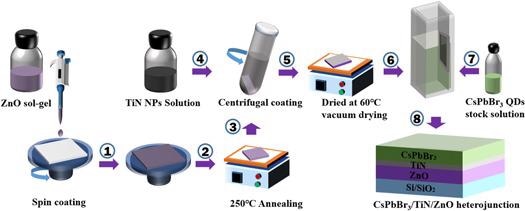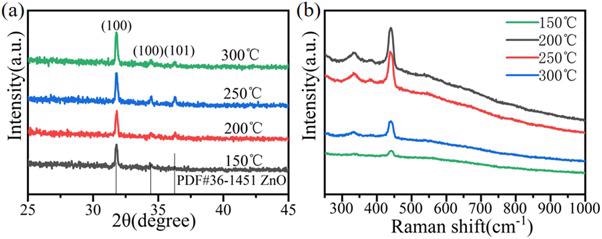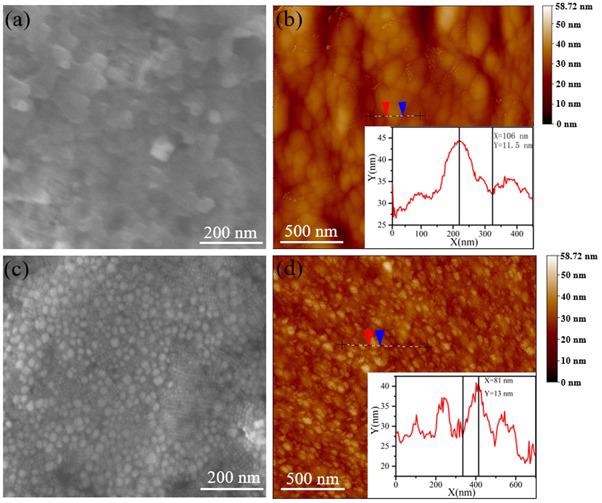In a study published in Material Research Express, a group of researchers prepared TiN/CsPbBr3 heterostructure that could transport more electrons quicker and minimize non-radiative exchange with the aid of TiN nanoparticles.

Study: Enhanced fluorescence of CsPbBr3/ZnO heterojunction enabled by titanium nitride nanoparticles. Image Credit: CI Photos/Shutterstock.com
In doing so, improved heterojunction fluorescence might lead to novel solar, LED, photodiodes, phototransistor, and photo-sensing applications.

Figure 1. Schematic of the fabrication process of CsPbBr3/TiN/ZnO heterojunction. © Jiang, J., Bai, Z., Yao, H., and Qin, S. (2022)
Titanium nitride nanoparticles were used by researchers to improve the fluorescence of CsPbBr3/ZnO heterostructures. When the thickness of TiN was around 50 nm, the fluorescence of the CsPbBr3/ZnO/TiN heterostructures was almost 3 times greater than that of the CsPbBr3/ZnO heterostructure.
Halide Lead Perovskites Quantum Dots in Energy Applications
QDs composed of halide lead perovskite are considered a potential candidate for semiconductor materials. Because of their high durability, electronic affinity, photoluminescence, narrow bandgap, and high quantum efficiencies, CsPbBr3 QDs have become prospective contenders for usage LEDs, optical absorption materials, and optoelectronics.
When combined with other metal oxide semiconductor nanomaterials, CsPbBr3 QDs (photoanodes) have subsequently been widely described as being capable of producing heterojunctions.
Suppression of Heterojunction Fluorescence
On the surface of metallic oxides, several cracks and impurities may transport entrapment on the heterogeneous junction, enhance carrier exchange, and inhibit photons, culminating in heterostructure fluorescence reduction.
The efficiency of heterojunctions in terms of enhanced illumination performance has received a lot of attention.
Strategies to Enhance the Fluorescence of Heterojunction
Incorporating nanomaterials or a thin coating on top of a metallic oxide can aid in overcoming the material's inherent bandgap constraints. Some researchers utilize a thin gold coating to boost the fluorescence of heterostructures.
The photoluminescence of gold NPs may encourage the formation of heat carriers, promoting the use of photonic transmitters in the heterostructure of PQDs and thereby increasing heterostructure fluorescence.
Due to their substantial carrier density, Au NPs are favored for thermoelectric systems. Its high cost, on the other hand, limits widespread manufacture.

Figure 2. (a) XRD 2θ scan pattern of ZnO film at different annealing temperatures; (b). Raman spectra of ZnO film at different annealing temperatures. © Jiang, J., Bai, Z., Yao, H., and Qin, S. (2022)
In comparison, high conductivity materials like titanium nitride (TiN) and chromium nitride (CrN) have a bandgap value comparable to noble metals. These materials are low-cost and require just a few steps to prepare. As a result, they are intriguing contenders for efficiently heated electron emission in the visible range.
Benefits of Titanium Nitrate in Optoelectronics
In semiconductor applications, TiN NPs are one of the most extensively employed nanoparticles.
The p-orbital electron density of nitrogen in TiN is smaller than the Fermi exciton because the electronic structure is made up of electrostatic interactions, chemical bonding, and metalcore bands, resulting in transport comparable to that of unpaired electrons in noble metals like gold and silver.
TiN is a quasi-metallic semiconductor with a high conductivity that allows it to substitute noble metals like Au while also making carrier movement and capture faster.
The TiN film may also operate as an extractor by specifically contacting the electro-conductive and crevasse characteristics, allowing carriers to be separated and extracted.
The researchers used the rotational casting technique to deposit TiN NPs on the top of ZnO films, resulting in TiN/ZnO heterostructures.
Heterogeneous self-assembly of CsPbBr3 QDs was used to create a CsPbBr3/ZnO/TiN heterostructure. To improve fluorescence, TiN NPs were used to alter the route of electron transmission in the heterostructure.

Figure 3. AFM surface morphologies of CsPbBr3/ZnO and CsPbBr3/TiN/ZnO heterojunctions. (a). AFM morphology of CsPbBr3/ZnO heterojunction; (b). The size distribution of CsPbBr3 QDs on the surface of CsPbBr3/ZnO heterojunction; (c). AFM morphology of CsPbBr3/TiN/ZnO heterojunction; (d). The size distribution on the surface of CsPbBr3/TiN/ZnO heterojunction. © Jiang, J., Bai, Z., Yao, H., and Qin, S. (2022)
Research Findings and Conclusion
Researchers used self-assembly and rotational casting procedures to manufacture CsPbBr3/ZnO and CsPbBr3/ZnO/TiN heterostructures in this research, and the photoluminescence impact of TiN NPs on the CsPbBr3/ZnO heterostructure was thoroughly investigated.
With a TiN layer thickness of 51 nm, the fluorescence of the CsPbBr3/TiN/ZnO heterostructure was thrice than that of the CsPbBr3/ZnO heterostructure. This was ascribed to TiN NPs' plasmon resonance state acting as an intermediary energy state between CsPbBr3 QDs and ZnO, allowing for faster electron transport and less non-radiative recombination at the heterojunction boundary.
The electrons of CsPbBr3 QDs were more readily lost during the transmission when the TiN NPs layer thickness was raised, leading to the destruction of the heterostructure CsPbBr3/ZnO/TiN radiation fluorescence. Solar cells, photodiodes, LEDs, photosensors, and optoelectronics may all benefit from this fluorescence intensification and energy conversion mechanism.
Reference
Jiang, J., Bai, Z., Yao, H., and Qin, S. (2022). Enhanced fluorescence of CsPbBr3/ZnO heterojunction enabled by titanium nitride nanoparticles. Materials Research Express. https://iopscience.iop.org/article/10.1088/2053-1591/ac55c6
Disclaimer: The views expressed here are those of the author expressed in their private capacity and do not necessarily represent the views of AZoM.com Limited T/A AZoNetwork the owner and operator of this website. This disclaimer forms part of the Terms and conditions of use of this website.